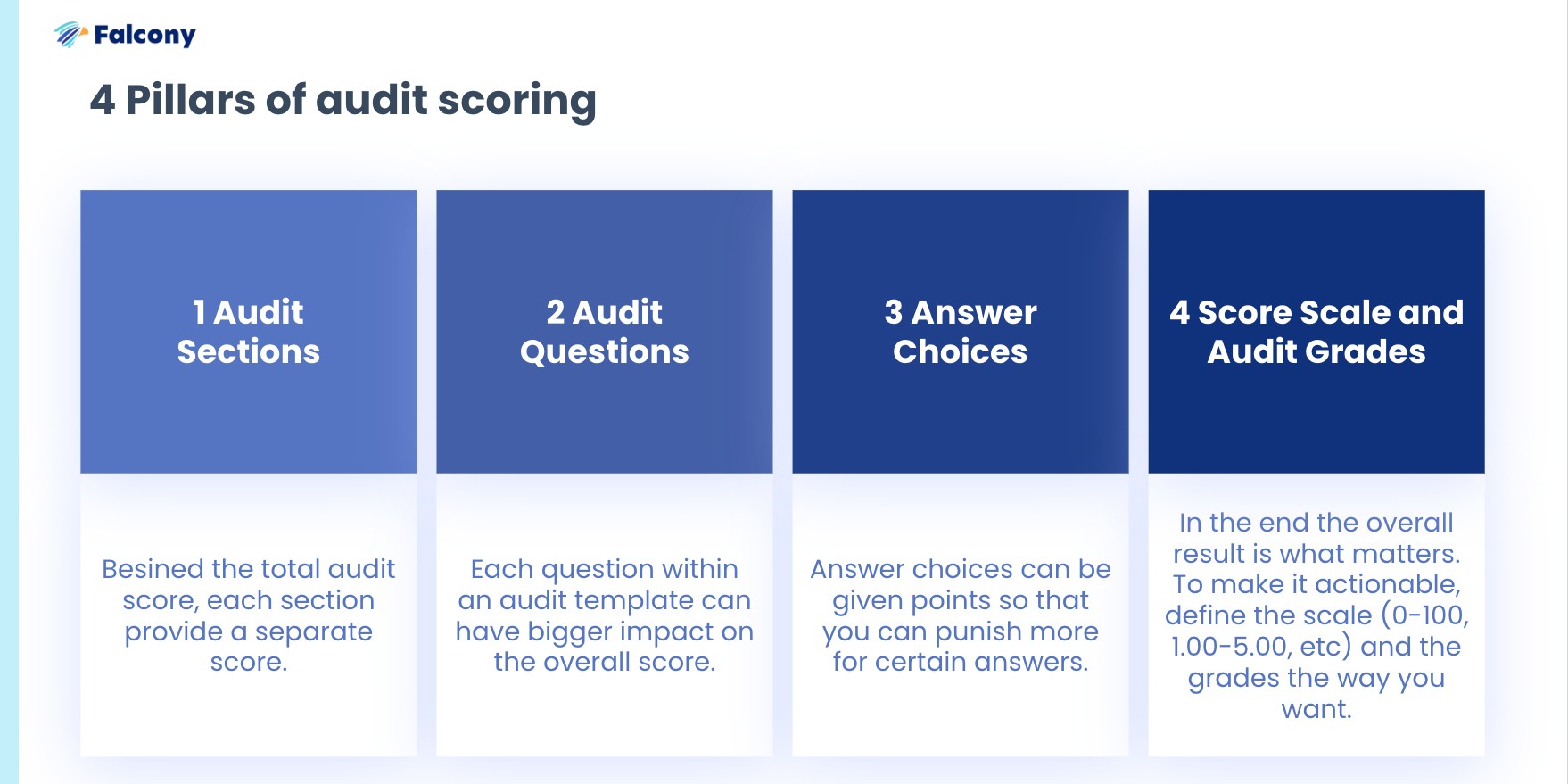Nuts and bolts of audit scoring
When it comes to audits and inspections, the scoring system is a crucial aspect to consider. The ability to compare scores over time allows organizations to track progress and identify areas for improvement. In this post, we will break down the components of the scoring system and explain how they work together to create an accurate and comprehensive evaluation.
First, it all starts with scoring the entire audit or inspection to allow for comparisons over time and between audit targets. This is what most people think when considering audit scoring, but where do the scores come from are from items or questions in the audit that are divided into logical sections.
Hence, it is also important to score each section within the audit or inspection separately. This allows for a more detailed analysis of specific areas and can help identify strengths and weaknesses within individual audits.
Weighing individual items within the audit or inspection can also have a significant impact on the overall score. By assigning different weights or values to specific items, organizations can ensure that important areas are given more consideration in the final score. This can be as simple as giving double weights for some questions but it can go as deep as having decimal-number weights for certain items.
Additionally, answer choices for each question can also be weighed separately. This allows for a more detailed evaluation of specific responses and can provide a more accurate representation of an organization's performance. Again there’s a degree to how much detail you can give weighing answer choices: on most cases giving one point for yes and zero points for no answer make sense but we’ve seen companies giving minus points also.
Don’t forget to take into account Not Applicable items or answers either. These are the questions in the audit that you couldn’t answer and hence they shouldn’t be included in the final score calculation.
The score scale used can vary, but it is important to choose one that is appropriate for the organization and easy to understand. Common options include a 0-100% scale, a 1.00-5.00 scale, 1.00-3.00 scale, or even an A-F scale.
Finally, it is helpful to define grades or levels within the score scale and to use color coding to easily distinguish between them. This allows for a clear understanding of how an organization is performing and where improvements can be made.

Overall, understanding the scoring system for audits and inspections is crucial for organizations to evaluate their performance and identify areas for improvement. By considering each component of the system, organizations can ensure that their evaluations are accurate and comprehensive.
Let's consider a fictional audit of a retail store.
The retail store is being audited for compliance with health and safety regulations, as well as customer service standards. The audit is divided into several sections, including:
- Building maintenance and safety
- Employee training and safety
- Customer service
- Sales and inventory management
Each section has a set of criteria that must be met, and each criteria is assigned a weight based on its importance. For example, employee training and safety may be given a higher weight than sales and inventory management, as it is considered more critical to the store's operations.
At the end of the audit, an overall score is calculated by adding up the scores for each section and dividing by the total number of sections. This overall score is then used to determine a grade, such as "excellent", "good", "fair", etc.
For example, if the store receives a score of 85 out of 100, it would be considered "good". This score is then recorded and can be used for comparison in future audits.
In the next audit, the store receives a score of 90 out of 100. This means that the store's performance has improved compared to the previous audit. By scoring the entire audit, the store can see that it has made progress in improving its compliance with health and safety regulations and customer service standards.
Conclusion
In conclusion, scoring the entire audit or inspection allows for comparisons over time, which is essential for organizations to track progress and identify areas for improvement. By calculating an overall score or grade, organizations can see how they are performing relative to their own past performance and set goals for future audits or inspections.
Are you interested to discuss how our Falcony Audit solution could benefit your organisation? Contact us and let us give a demo!
We are building the world's first operational involvement platform. Our mission is to make the process of finding, sharing, fixing and learning from issues and observations as easy as thinking about them and as rewarding as being remembered for them.
By doing this, we are making work more meaningful for all parties involved.
More information at falcony.io.

Related posts
How to Create a Clear Customer Experience Vision in Commercial Real Estate
In today's competitive commercial real estate market, delivering an exceptional customer experience...
Top 5 customer experience skills in commercial real estate
Providing excellent customer experience is essential in the commercial real estate industry, as it...
Designing Innovative Spaces for an Exceptional Tenant Experience
In the fast-evolving business of commercial real estate, the key to attracting and retaining...



